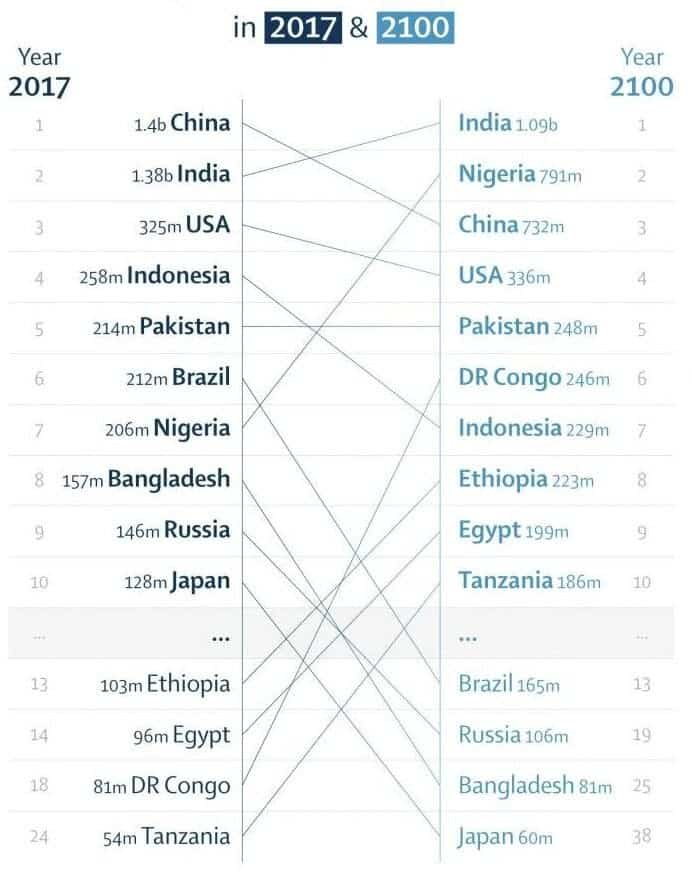The world’s population will likely peak at 9.7 billion in 2064, followed by a decline to about 8.8 billion by 2100, as access to education and contraception gets better. This is a big difference from the previous UN estimate of 10.9 billion.
This change expected to affect almost every country on Earth, causing significant shifts in global economic power, with immigration playing a big role in stabilizing populations.

Researchers from the Institute for Health Metrics and Evaluation at the University of Washington’s School of Medicine found that the fertility rates of 183 of 195 won’t be high enough to maintain the current population by 2100.
This will be more severe for a group of 23 countries such as Italy, Spain, Thailand, and Japan, whose population is expected to shrink by more than 50% by the turn of the century. On the other extreme, sub-Saharan Africa would see its population triple, which means just under half of the world’s population will be African by the end of the century, and most population growth will come from Africa.
The modeling study anticipates a significant decline in the working-age populations in several countries such as India and China. This will affect their economic growth and could even have negative consequences for workforces and social support systems, the researchers argue.
“The world, since the 1960s, has been really focused on the so-called population explosion,” Dr. Christopher Murray, who led the research, told CNN. “Suddenly, we’re now seeing this sort of turning point where it is very clear that we are rapidly transitioning from the issue of too many people to too few.”
Declining population
The team at the University of Washington used data from the Global Burden of Disease Study from 2017 and predicted that the populations to shrink the fastest will be in Asia and eastern and central Europa. For example, the population of Japan will reduce from 128 million in 2017 to 60 million in 2100. While Japan is an extreme example, many other countries are expected to follow a similar trajectory.
A group of 34 countries is predicted to see their population decline by up to 50%. This includes Portugal, from 10 to 5 million, South Korea, from 53 to 27 million, Thailand, from 71 to 35 million, and Spain, from 46 to 34 million.
Not only will the population be reduced but also the society will be older, which will affect economic growth and cause substantial societal shifts.
Even China and India, the two major drivers of population growth in recent decades, will see their population decrease substantially.

On the other hand, the population of sub-Saharan Africa would triple over the course of the century, going from one billion in 2017 to three billion in 2100.
According to the study, North Africa and the Middle East are the only other regions predicted to have a larger population in 2100 than in 2017, reaching 978 million from 600 million in 2017.
“This important research charts a future we need to be planning for urgently,” Richard Horton, the editor-in-chief of The Lancet, where the study was published, said in a press release. “It offers a vision for radical shifts in geopolitical power, challenges myths about immigration, and underlines the importance of protecting and strengthening the sexual and reproductive rights of women.”
Age structure and immigration
The age structure is also expected to shift. The number of people over 65 would reach 2.3 billion globally in 2100, compared to 1.7 billion people under the age of 20. Meanwhile, the global population older than 80 would increase six-fold, going from 141 million in 2017 to 866 million.
Researchers argued that these “dramatic declines” in working-age populations in countries such as India and China, will make economic growth more difficult and cause shifts in global powers. “It’s already starting — this is something that is not in the distant future,” Murray said.
Under these circumstances, immigration is not only a possibility to address these problems — it’s almost a necessity.
Immigration could, at least partly, offset declining fertility rates. Countries that have liberal immigration policies will find themselves better equipped to maintain their population size and support economic growth. This means will enable countries to maintain a healthy balance in the workforce which could become a major geopolitical advantage. In other words, isolationist countries have much more to lose in the coming decades.
“The positive impacts of migration on health and economies are known globally. The choice that we face is whether we improve health and wealth by allowing planned population movement or if we end up with an underclass of imported labor and unstable societies,” Professor Ibrahim Abubakar of University College London, who was not involved in the research, told the BBC.
This could also be very significant for environmental concerns. Population growth has been one of the drivers of greenhouse gas emissions, although the connection is not always straightforward. In 2019, Africa’s emissions were 4.6 times lower than those in North America, although Africa’s population is double. A lower population doesn’t necessarily mean lower emissions.
The study was published in the journal The Lancet.









